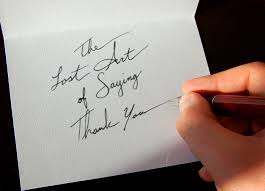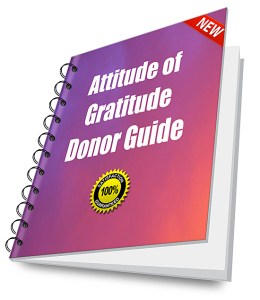Thanking donors is the one thing most nonprofits do not spend enough time thinking about. Too often I find that staff spend 95% of their time crafting their fundraising appeal and getting embroiled in project management — design, layout, printing, postage, etc. Finally, the letter (or e-appeal) is ready to launch. The mailing is dropped. The button is punched. And… voila! Gifts start to arrive! But then what?!
After you’ve sent out your appeal is too late to start thinking about what your thank you letter or email will say. Or who will sign it. Or whether someone who donates online will also receive an actual letter. Or thank you call. Or who will make the call. Everything must be well thought-out in advance. You must be ready to go, with different templates and strategies for different target audiences, well before you’ve asked for your first donation.
What would Miss Manners have to say about the way you too often focus more on the gift than on the giver? She would not be happy. Not happy at all. So, make a vow to remedy this situation before we kick into prime giving season.
9 Thank You Mistakes to Avoid
1. Delaying
Your thank you should get out the door within 48 hours. Period. No arguments. People will try to tell you they don’t care if they don’t hear from charities for a week… a month… whatever. Don’t believe them. Penelope Burk, author of “Donor-Centered Fundraising” has proved otherwise. If you don’t thank donors promptly, you’re destroying all the rest of your hard work. The most important predictor of likelihood to give is recency. If it takes you over a month to process a donor’s gift, then you’re missing out on their most-likely-to-give-again period. Timely follow up matters. A lot.
2. Misspelling
You absolutely must spell the donor’s name correctly. There is no excuse for getting this wrong. None. It’s just plain sloppy. And it borders on rude. How would your friend feel if you misspelled her name on a thank you card for your birthday gift? Your friend would feel like you didn’t know who they were. Enough said.
3. Failing to personalize the salutation
Personalization matters. Per the most recent Abila Donor Loyalty Study, approximately 71% of donors feel more engaged with a nonprofit when they receive content that’s personalized. It’s so easy to do this these days with CRM and mail merge programs. Not doing it is lazy. Unless you absolutely know you have a constituent that prefers a formal salutation, use the familiar (i.e., first names). Except for judges and elected officials and military personnel, almost everyone else goes by their first name. And if they use a nickname (or have a pesky initial), then you’d better put this into the right field in your database. There’s nothing quite as awkward as “Dear Ms. R. Beatrice” when the donor goes by “Bitty.” Remember: You’re trying to build a personal relationship. Be friendly.
4. Yawn-inducing content
A thank you letter is an opportunity to make your donor feel warm and fuzzy. When you begin your letter with “Thank you on behalf of the board, staff and all those who are helped by your generosity…,” you put your donor to sleep. Generic and/or jargon-filled acknowledgements are just you checking the thank you off your list. They do little for the donor, and less for you. They certainly don’t set your donor up to want to give to you again.
Jimmy will go to sleep tonight with a full tummy, because you cared. (Food program)
You remembered, because Gloria could not. (Alzheimer’s care)
The glass of water she drinks today will not make her sick. (Clean water)
Rather than providing a transactional receipt, offer a transformational donor experience.
5. Neglecting to mention something they asked you to do
If your donor asked for their gift to remain anonymous, the thank you letter should reflect this. If they earmarked the gift for a particular purpose, they want to be reassured that this is how you’ll use the money. If they asked for pledge reminders, they want to know you’ll stay on top of this. And so on. Donors want to know you listen.
6. Forgetting to tell them the specific impact the gift will have
Even bar mitzvah kids know to tell folks that they really needed that fountain pen and they’ll be putting it to work immediately to write thank you notes! The donor wants to know (1) you really needed their gift, and (2) how wisely you will use their investment for the purpose they intended.
7. Overlooking the opportunity to provide something of value
Remember, philanthropy is all about the value-for-value exchange. Good donor stewardship requires a give and take; a back and forth. Sadly, giving isn’t always its own reward. It’s up to you to reward your donor and help them to feel like the hero they are. What gifts can you give? A way they can volunteer… a thank you from a supporter… a means to get involved as an advocate… a list of tips they can use? Give your donor something of value now to continue the circle of giving and getting.
8. Not including the name of a contact person
What if the donor has a question? What if you made a mistake in their letter? What if they want to do more for you? How are they going to reach the right person if you don’t give them a name, phone number and email? Again, this is about building personal relationships. Donors must be able to reach you easily.
9. Sounding like you’re asking for more
You’ll notice I didn’t say simply asking for more. While this is certainly a ‘no-no’ (a thank you should be pure), it’s equally important to avoid the appearance of asking. Take a good look at your thank you letters. Do they sound a lot like a solicitation? Are you still moaning about the need in the community; bragging about all the people you help, and adding that there’s still so much to do? An Abila Donor Engagement Study found that 21% of donors say they were never thanked for their gift. Some weren’t, but my hunch is that a lot were. They just didn’t perceive what you sent them to be a thank you. Too often thank you letters sound exactly like fundraising letters.
Serious about donor retention?
You may want to get my Attitude of Gratitude Donor Guide. It’s filled with everything I’ve learned about donor acknowledgement over the years, all tucked it into one handy no-nonsense guide on the practice of gratitude. 106 full pages, with lots of ready-to-use samples and templates. Plus it includes the Creative Ways to Thank Your Donors E-Book — with 60+ ideas for you to steal! All Clairification products comes with a 30-day no-questions-asked money-back guarantee.
Get your E-Guide here.
Parts of this article were originally published 11-18-12 on Clairification.








Hi Claire, I just found your blog as we are entering new grounds. We recently started fundraising online for our local gymnastics center I volunteer at in Brandon, Manitoba. We ended up trying out a few platforms but settled on one that provided the lowest fee structure (Donorhut). I’m wondering if you feel we should thank our donors with personalized messages after they send a donation to use online. Or do you feel that online donations don’t require the personal touch that we usually apply to our local fundraising at the community center / mall? I only ask because this platform has a place where we can put a generic thank you message, however we are fearful that it may come off as “robotic”. We are really new to this and we would really appreciate your advice. I added a link to the platform we are using (if you are familiar with it) and hopefully you will be willing to guide us so we can maintain the support and relationships of our community.
I can’t comment on any particular platform, but will say that the more you can personalize your thank you’s the better. People who give online are still people, and they want to be appreciated as people. Follow Penelope Burk’s mantra and “show donors you know them.” All thank you’s should be (1) Prompt, (2) Personal, and (3) Powerful (demonstrating the impact of the donor’s gift for the purpose for which they intended). Hope that helps! If you need more, please contact me directly. All the best.
Wow Claire, this is exactly what I was looking for. Thank you very much. Consider us new followers of your blog! If we hit any speedbumps we will be in touch. Thank you!
I would add two things:
Abandon the honorific. As a woman constantly being addressed as a “Mr.”, I have to wonder why it makes any difference to the organization what my gender is. Just use my name.
And use MY name. The one name I give you. Not the one in your years-old database under the ex’s name. Not both names on the check if the other one is crossed out.
That’s a great add, and I heartily agree! I advise folks to use informal salutations as a rule UNLESS they know the person prefers otherwise, or is a congressperson or judge or someone who goes by the term “Honorable” before their name. It’s almost 2017, not 1957.
You caught me being out of date Janice. Sigh… The article was published a couple of years ago, and the survey is no longer live. I see it’s probably time for me to do a new one! Thanks for your interest, and for keeping me on my toes. 🙂
Hi Claire,
I just happened on your site, I have a question about being too thankful. Is there such a thing? I was told my thank you letter then our donors too much. Any advice? I can send you a sample of the thank you note in question.
Thank you,
Yeimy Walker
Unless you’ve written something that’s a deliberate parody, I think it’s difficult to thank too much. People tend to appreciate warmth, even gushiness, in their thank you’s. If you want to Grab an “Hour of Power” I can review what you’ve got and talk you through it. Or you can grab my Thank You template and Guide: https://clairification.com/anatomy-of-a-nonprofit-thank-you-letter-plus-sample-template/. Good luck!
XX Foundation cannot thank you enough for your phenomenal donation and support. Your continuous generosity does not go unnoticed by XX Foundation. We value your contribution and because of you, XX Foundation can continue to further the work we do and create a brighter future for children, adolescents and families that experience mental health.
Thank you from the bottom of our hearts!
We have a volunteer helping write some of these and I think she did a beautiful job. I personally believe donors should feel like rock stars and be gushed over. let me know what you think. I blanked out the name of the organization FYI.
This is lovely. I’d edit a bit to take out so many mentions of “XX Foundation” and “we” doing the work, and give the credit even more to the donor for doing the work. But it’s heartfelt. Make sure, however, that you don’t overdo it with adjectives like “phenomenal.” This may ring true for some donors, but not for those who made a token gift. Try a word like heartfelt,thoughtful, important or meaningful.
Thank you for the help, I’ll keep the adjectives in mind. And tweak it a bit. I just felt I needed some clarification on how much is too much when thanking a donor.